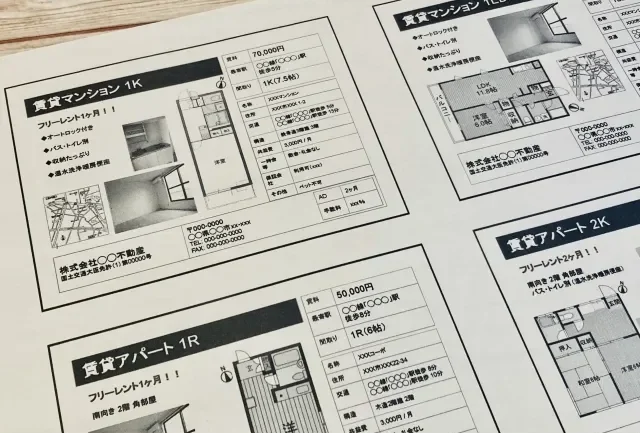What does "Madori" mean, including a list of terms such as R, K, S, etc. and recommended floor plans?

For foreigners, renting a room in Japan can be quite a daunting task. When looking for a room, you may be puzzled by a series of seemingly unintelligible descriptions such as "1R" and "3LDK". In fact, these are unique Japanese expressions for floor plans. A room layout is a way of arranging the space between rooms, that is, the arrangement and number of rooms.
This article will explain in detail the meaning of these Japanese floor plans, the use of symbols, and popular floor plans. Please refer to it to find your favorite room.
If you are looking for a room in Tokyo, we also recommend the following articles
▶︎ Where is the cheapest rent in Tokyo? Here are some recommended areas!
▼Goandup Picks Click here for recommended articles!
- Required before studying abroad! Goandup Nihongo+, an online Japanese language learning service
- This page introduces services for foreigners who wish to study in Japan or improve their Japanese language skills to learn Japanese online.
- Goandup Salon" community for foreigners living in Japan
- We introduce an online community where foreigners living in Japan can exchange information and interact with each other to support their life in Japan.
- Goandup Study" supports foreigners who want to study in Japan.
- This section introduces study abroad support services that provide comprehensive support to foreigners who wish to study in Japan, from preparation for study abroad to living in Japan.
- Where can I buy a prepaid SIM in Japan? Recommended SIM cards for foreigners are also introduced.
- How to purchase a prepaid SIM and suitable SIM cards for foreigners.
- The Complete Guide to Pocket Wi-Fi in Japan for Foreigners!
- We introduce how to select and recommend pocket Wi-Fi products that can be used conveniently in Japan.
- The Complete Guide to Finding a Job in Japan! Finding a job, changing jobs, and part-time work for foreigners
- This site provides foreigners who want to work in Japan with comprehensive information on how to find a job, recommended job sites, and other information necessary to find a job.
What is the meaning and English expression of "Madori"?

The term "floor plan" translates directly to "room arrangement," but in simple terms it refers to the layout of a room. In English, it is expressed as "floor plan" or "room layout.
A floor plan is a diagram that shows at a glance the number, size, and arrangement of rooms in the property. For example, the living room is 12 tatami mats in size and faces south, and there are two 6-mat Western-style rooms next to it. The floor plan also depicts not only the rooms, but also the locations of water features such as toilets, baths, kitchens, and closets. In addition, it also shows where the doors leading in and out of the rooms are located, which way they open, and where the windows and veranda are located.
It may look like a complicated drawing, but it is an indispensable item when searching for a room, as it gives you a general idea of the property. Most real estate websites also include a floor plan, and when visiting the site, it will be easier to get an idea of the property if you tour the property with the floor plan in hand.
Differences between Japanese and foreign floor plan designations

Overseas, when describing a floor plan, it is common to classify properties by the number of bedrooms, assuming the existence of a living room and kitchen. For example, "2BR" or "3BR" means 2 or 3 bedrooms, respectively. The term "Studio" is also often used to describe a studio type property.
On the other hand, the presence or absence of a living room and kitchen is also important in the Japanese floor plan description. This is because many one-room type properties are common in Japanese housing situations, and living rooms and kitchens may not be independent. For this reason, a rule has been established that living rooms are indicated by "L" and kitchens by "K," with the first letter of each being used in the alphabet.
In addition, the size of the bedroom is also important in Japan, whereas in other countries, the size of the bedroom is not a factor. rooms larger than 6 tatami mats are called "youshitsu" and rooms as small as 4.5 tatami mats are called "nando," meaning that the floor plan includes not only the number of rooms but also information on the size of the room.
If you understand these differences, you should have some idea of what you are looking for when you see the Japanese floor plan notation. In the next section, we will explain in detail the meaning of the alphabet commonly used in Japanese floor plans.
Quick alphabetical list of floor plan types

In Japanese room layouts, numbers and letters are almost always used in combination, as in "1K" and "2LDK. The numbers represent the number of rooms (excluding living room, dining room, and kitchen), and the letters represent the type of room. In other words, "1K" means one room with a kitchen, while "2LDK" means a layout with two rooms in addition to the living room, dining room, and kitchen.
There are five main types of alphabets used to describe floor plans
| R (Room) | The "R" stands for "Room" or "room. A layout in which the kitchen is inside the room is described as "1R," and is generally called a "studio. However, "R" is used only for 1R, and "2R" is not used when there are two or more rooms. |
| K (Kitchen) | The "K" stands for "Kitchen (kitchen/kitchen)." When it is written "1K" or "2K," it means that there is a kitchen, i.e., the kitchen is separate. It is not just one room, but also includes the nuance that the room and kitchen are separate! |
| D (Dining) | The "D" refers to "Dining," or the room where meals are taken. It can be integrated with the living room or a completely separate dining room and kitchen." D" is rarely used alone; it is usually used in combination with other symbols, such as "1DK" or "2LDK." |
| L (Living) | The "L" stands for "Living" and refers to a room used as a space for entertaining and relaxing. Living rooms are often Western-style rooms and are also called "居間" in Japanese. The term "LDK" is often used to describe a room that is combined with a dining room and kitchen. |
| S (Servise room) | "S" is an acronym for "Servise room" and refers to a room that is not large enough or equipped with sufficient space, such as a storage room converted from a closet." It is indicated by adding +S to the floor plan, as in "1LDK+S". It can be used as a room, but it is used only to indicate that it is not a formal living room. |
If you remember the above five, you should be able to understand most floor plans. Try to imagine from the alphabetical combinations to find the floor plan that best suits your needs.
What kind of floor plans are available in Japanese apartments? Before understanding floor plans, it is helpful to know what a typical Japanese apartment looks like in terms of size, facilities, and rent rates. For more information, please refer to this article "What is a typical apartment in Japan like? Size, Facilities, and Rent Rates ExplainedPlease check out the explanation in the following section.
【 What is the recommended floor plan for 】 by number of people?

Now that you understand the meaning of the Japanese floor plan notation, let's look at the recommended floor plans according to the number of people living in the house. We will divide the explanation into cases of one person living alone, two people living together, and three to four people living together.
1. recommended floor plan for living alone
When living alone, having too many rooms makes cleaning more difficult and increases the cost of rent. For this reason, we recommend 1R, 1K, 1DK, and 1LDK layouts, which have only one or two rooms.
1R is a type where the room and kitchen are all together, and although the rent is inexpensive, it has the disadvantage of being easily lived in. 1K has a separate kitchen, so you can live without worrying about the noise and smell of cooking.
The difference between 1DK and 1LDK is whether the living room and dining room are separated. Generally, a room is called a "living room" if it is more than 8 tatami mats in size, and a "dining room" if it is less than 8 tatami mats in size. If you want a spacious living room, you should choose 1LDK.
2. recommended floor plan for two people living together
If you are living together as a couple or sharing a room, the floor plan you choose will depend on whether you share or separate bedrooms.
If you share a bedroom, 1DK or 1LDK is recommended. With one bedroom and one living room, it will be easier to communicate while maintaining privacy. Since there are many shared areas, rent is also relatively inexpensive.
On the other hand, if you want to have separate bedrooms, 2DK or 2LDK is the best choice. This is suitable for those who have different life rhythms and want to spend more personal time. However, the rent will be higher due to the larger number of rooms.
Recommended floor plan for three or four people
For three- or four-person households, the key is how to distribute the living room and private rooms. For families, 3LDK or 4LDK is recommended. For a family of four (parents and two children), a 3LDK is a good size with a living room and three private rooms. If you want to reserve a study room or hobby room for your children, a 4LDK is also a good choice.
For a share house, we recommend choosing a 3DK or 4DK with one room per person for privacy. The living room can be used as a space for everyone to socialize. The rent will be higher, but you should be able to live comfortably if you set rules and make good use of the space.
The more people you have, the more storage space you will need. We recommend choosing a property with a family closet or a storage room. Choose a floor plan that is comfortable for your lifestyle.
Useful information and support for living in Japan

Living in Japan is fascinating, but it is not uncommon to face many challenges due to language barriers and cultural differences. For example, you may encounter difficulties in all aspects of life, from using keigo (honorific expressions) in everyday and business situations, to difficulties in finding housing, using public services, preparing for the JLPT exam, and even meeting new friends and loved ones.
At such times, Goandup Salon will be your reliable partner!
Our community provides support and information to help foreign residents in Japan to make their life in Japan richer and more comfortable.
- Japanese Language Studywill meet the needs of all levels, from daily conversation to the use of keigo in business situations, to efficient Japanese language learning methods and preparation for the JLPT exam.
- livingaspect of the program provides concrete advice and information on how to establish a foundation for living in Japan, including explanations of Japanese culture and rules, finding housing, and how to contract public services and living infrastructure.
- Jobs & CareersRegarding the "what if" section, we can help you find a job, change jobs, and understand Japanese business etiquette and workplace culture, which are key to a successful career in the workplace.
- Travel & Dining Guidewill introduce you to hidden gems in Japan, must-try gourmet information, and other unique local attractions to help you experience Japan more deeply.
If you have any questions or concerns about life in Japan, Goandup Salon is here to help you! We will wholeheartedly support you to make your life in Japan smoother and more enjoyable.
For more information, click here ▼
【 Summary 】 Understand the Japanese floor plan and find your favorite room.
How was it? At first glance, Japanese floor plan notation may seem complicated, but it is not that difficult once you understand the rules.
Simply combine the five letters of the alphabet: living room (L), dining room (D), kitchen (K), room (R), and service room (S), and add a number representing the number of rooms.
Of course, it is necessary to verify on site whether the actual rooms are exactly as you imagined the floor plan. This is because there is a lot of information that cannot be obtained from a floor plan alone, such as floor space, size of storage space, and direction of windows. But if you read this article and keep the basics of floor plans in mind, you should be able to narrow down the listings that are close to what you want.
If you find a property you are interested in on a real estate website, first check out the floor plan. Then, you may be able to find your ideal room after actually viewing the room and checking the atmosphere of the room.
Finally, here are some articles we recommend for those who are looking for a room outside of Tokyo. ".Which prefectures have the cheapest rent in Japan? Compare rent prices by regionIn the "Rent Comparison" section, we compare rent prices in different regions throughout Japan. There are many areas where rent is cheaper than in Tokyo and Osaka. Find your favorite floor plan and start your ideal new life.






